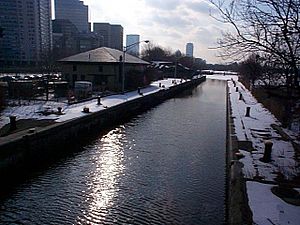Charles River Dam Bridge facts for kids
Quick facts for kids Charles River Dam Bridge |
|
|---|---|
| Coordinates | 42°22′05″N 71°04′15″W / 42.3680°N 71.0708°W |
| Carries | six lanes of traffic ( |
| Crosses | Charles River at mile 1.0 |
| Locale | Boston, Massachusetts |
| Maintained by | Massachusetts Department of Conservation and Recreation |
| ID number | 160134 |
| Characteristics | |
| Design | steel bascule bridge |
| Total length | 25.0 m (82.0 ft) |
| Width | 25.6 m (84.0 ft) |
| Longest span | 19.2 m (63.0 ft) |
| Clearance below | 4.6 m (15 ft) |
| History | |
| Opened | 1910 |
The Charles River Dam Bridge, also known as the Craigie Bridge, is an important bridge in Boston, Massachusetts. It carries six lanes of traffic for cars and trucks, plus two sidewalks for people. This bridge crosses the Charles River, connecting the West End neighborhood of Boston to East Cambridge. The famous Museum of Science is located right on the dam and nearby areas.
The Charles River Dam Bridge is a special type of bridge called a bascule bridge. This means part of it can lift up to let tall boats pass underneath. It's maintained by the Massachusetts Department of Conservation and Recreation (DCR). The bridge is part of Massachusetts Route 28.
Originally, a lock was built into the dam near this bridge. A lock is like a water elevator that helps boats move between different water levels. This old lock was later replaced by three new ones further east. The former lock at the Charles River Dam Bridge now lets water and small ships flow freely. Taller ships still need the drawbridge to open.
A Look Back: History of the Bridge
The very first bridge at this spot was called the Canal Bridge. It was named after the Middlesex Canal, a waterway that connected different areas. A businessman named Andrew Craigie bought land on the Cambridge side. He planned to build a bridge there.
Investors formed a company in 1807. Their goal was to build a bridge from Leverett Street in Boston to Lechmere Point in Cambridge. The bridge opened in 1809 and soon became known as Craigie's Bridge.
Building this bridge led to new roads being created. These roads connected the bridge to the center of Cambridge and to Somerville/Medford. Craigie and his partners benefited from the growth that followed. More streets were built, and some were named after the investors, like Otis, Thorndike, and Gore streets. The bridge was sold in 1846 and became free to cross in 1858.
The current Charles River Dam Bridge was built in 1910. At the same time, a dam was constructed. This dam changed the lower Charles River from a tidal area (where water levels change with the ocean tides) into a freshwater basin. This helped reduce bad smells from sewage in the river. The bridge and dam were finished on June 30, 1910. A big fireworks show celebrated their opening on the Fourth of July. Thousands of people watched from the new Boston Embankment, which is now part of the Charles River Esplanade.
Construction of the Museum of Science began on the dam in 1948 and was completed in 1951.
Recent Updates: Bridge Improvements
The Massachusetts Department of Transportation (MassDOT) worked on the Craigie Bridge from 2010 to 2011. They fixed up the bridge and completely replaced the part that lifts up. This project was paid for by a statewide program to improve bridges.
Making it Safer for Bikes
In 2018, there was a sad accident involving a bicyclist on the bridge. Because of this, MassDOT announced safety improvements. In 2019, special signals for bicycles and protected bike lanes were added. This made the bridge safer for people riding bikes. To do this, the number of car lanes was changed to two in each direction.


